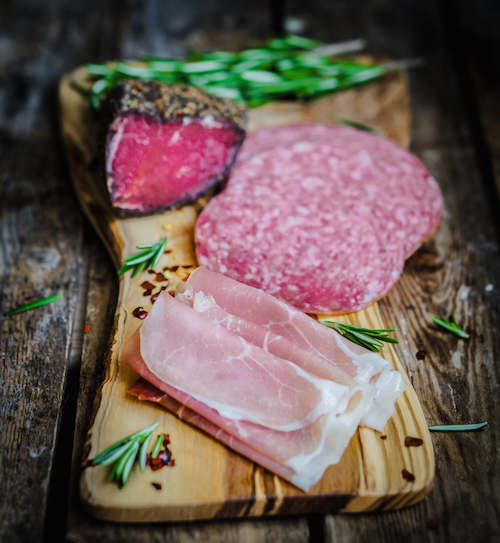
Cured meat is meat that has been preserved through ageing, drying, canning, salting, brining or smoking. The goal of curing is to slow spoilage and prevent the growth of microorganisms.
Curing dates back to ancient times, when it was essential for storing meat safely and preventing food poisoning. One of the most common cured meats we eat today is bacon, which is cured pork!
Essential Curing Ingredients
Essential curing ingredients include:
- Meat – you can use beef, pork, veal, lamb, poultry and fish.
- Salt – salt is the most important ingredient for curing, as it draws the water out of the meat and kills microorganisms. The less moisture in the meat, the longer it can be saved before being eaten.
- Sugar – although not required for curing, sugar is often added to counteract the harsh flavour of the salt.
- Nitrates and nitrites – these ingredients should be purchased in a ‘curing mix’ with added salt. They kill bacteria in the meat and also give the meat an appealing pink colour (without them, cured meat would be grey). Nitrates and nitrites can be harmful in large quantities, so it is essential that they are used carefully and sparingly. Curing methods/recipes should always be followed exactly.
Common Methods of Curing
Dry curing
Dry curing is often used to cure ham, bacon and smaller cuts of meat. Dry curing involves applying a curing mix directly on the meat, sealing the meat and then keeping it refrigerated while it cures. After curing, excess salt is removed by rinsing the meat and the meat is cooked before eating.
Wet curing
This method involves combining curing salt and water to create a sweet pickle solution. The meat is then either soaked in the mixture or it has the mixture injected into it. Like dry curing, this process takes place in a refrigerator and the cured meat needs to be cooked before it is eaten.
Combination curing
This method involves a combination of both wet and dry curing. Often used to cure hams, this method shortens the curing time and reduces the risk of spoilage because the process takes place inside and outside of the ham. The meat is left to cure in a fridge and needs to be cooked thereafter.
You can find more information about curing meat as well as in-depth
instructions at Amazing Ribs.
Is it Safe to Cure Meat?
Risk is inherent in any curing process or method of food preservation – but when meat is cured safely and effectively, it is safe to eat. If you want to make your own cured meats, here are some important safety guidelines to read before you do!
The information in this post is adapted from Off the Grid News, Morton Salt and the National Centre for Smoking and Curing.
 Return to News
Return to News

















